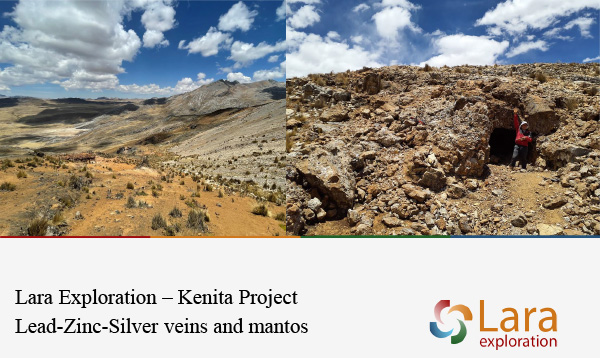Kenita (Puituco) Zinc Project
The Kenita Polymetallic Project is located in the Huancavelica Department of Central Peru. The mineral rights include the original 400 hectares of Puituco licenses acquired by Lara at government auction, where the Company completed a mapping and surface channel sampling program in 2018 (see Company release of June 12, 2018, for details) and the 2,200 hectares of Kenita licenses acquired from BHP in 2021 (see Lara news release of August 31, 2021 for details). For simplicity the Company has elected to now call the project Kenita.
The Project is located on a major NW-SE oriented regional structure, the Chonta fault, between the Bethania polymetallic deposit being redeveloped by Kuya Silver Corp. (KUYA: CSE), and the Riqueza project held by Inca Minerals Ltd. (IGC:ASX), both of which are host to mineralization similar in style. Minera IRL Ltd.’s (MIRL: CSE) Corihuarmi high sulphidation epithermal gold mine also lies on the same trend to the northwest. Larger mining companies active in the district include Anglo American, Teck and Penoles.
The Company’s 2022 field programs have substantially expanded the mineralized footprint, along six major breccia veins and five related mantos (mineralized limestone beds) with significant silver, zinc, and lead values. During the most recent mapping program a further 44 channel samples (from 0.5 meters to 5 meters in length) were collected in the central part of the property, with values ranging from less than detection limit of <1 ppm to 287 g/t silver (length weighted average of 46.49 ppm Ag), less than the detection limit of 20 ppm to 16.4% zinc (length weighted average of 4.37% Zn and with one sample assaying over 30 % Zn); and less than detection limit of 20 ppm to 10.1% lead (length weighted average of 2.99% Pb. Fourteen (14) samples (32% of the total samples) assayed in excess of 50 ppm Ag, 13 samples (29% of the samples) assayed in excess of 5% Zn and 15 samples (34% of the samples) assayed in excess of 4% Pb.
Mineralization comprises hydrothermal breccias filling NE-SW oriented tension structures (related to a major regional structure, the NW-SE oriented Chonta Fault) and related mantos, where fluids have been driven laterally into the Cretaceous-age limestone beds and recrystallized, brecciated and mineralized them. These veins and mantos are thought to be the upper part of a regional lead-zinc-silver system, with similar values as those reported by Inca Minerals from their Riqueza project located adjacent to the south of Kenita, and at Kuya Silver’s Bethania polymetallic deposit located to the northwest.
A series of veins were also identified in the western portion of the property where they are hosted by Tertiary-age volcanics along the edge of the Huayta Caldera, which is host to the Bethania deposit. Sixteen channel samples (from 0.5 meters to 3 meters in length) were collected in this first pass review of the area, with anomalous lead-zinc-silver values returned in places (maximum of 410 ppm Pb, 2040 ppm Zn and 6 ppm Ag). An additional claim has been registered to cover the western extension of these veins and more systematic mapping and sampling is planned both here and in the central portion of the property in 2023.
Quality Control and Qualified Person
QAQC AFC 2018: The 63 rock channel samples were collected by Lara’s consultant AFC Logistics S.A.C. and delivered by them to the ALS Peru S.A. laboratory in Lima. The samples were typically cut over 5m widths (range 0.5m to 7.4m) by hand or by electric jackhammer, depending on the rock hardness. The samples were analysed by 33 element ICP for base metals and silver and 50g fire assay for gold. Ore grade samples for zinc, lead and silver were reanalysed with a four-acid digest and AAS finish. Standard, blank and duplicate samples were analysed for QAQC purposes, and all reported in-range.
QAQC 2022: 60 channel samples were collected from veins within the project by Lara's consultant Juan Carlos Fernández and delivered by him and Lara's staff to the ALS Peru SA laboratory in Lima., These samples were collected manually from channels 1 to 3 m long and approximately 0.03 meters deep using a hammer and chisel. The samples were analysed for base metals and silver by 32 element ICP. Ore grade samples for zinc, lead and silver were reanalysed with a four-acid digest and AAS finish.
Michael Bennell, Lara’s Vice President Exploration and a Fellow of the Australasian Institute of Mining and Metallurgy (AusIMM), is a Qualified Person as defined by National Instrument 43-101 Standards of Disclosure for Mineral Projects and has approved this technical disclosure and verified the technical information.

